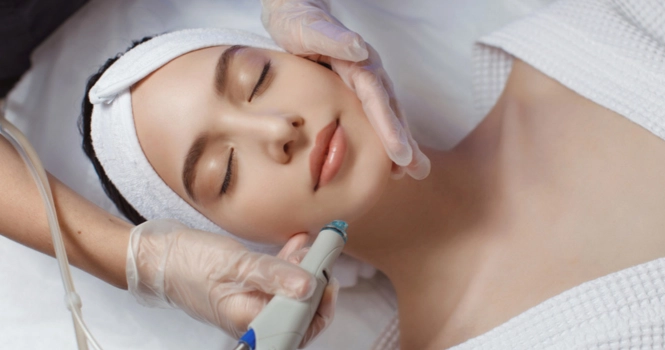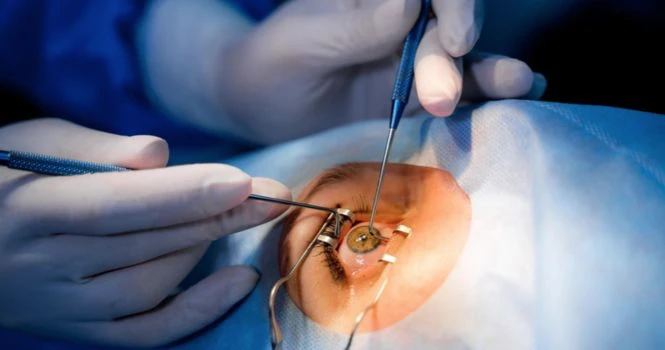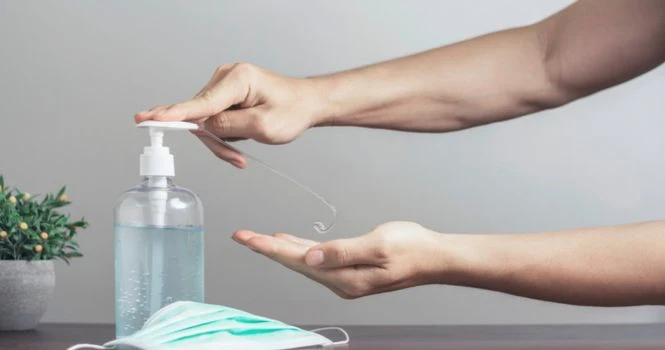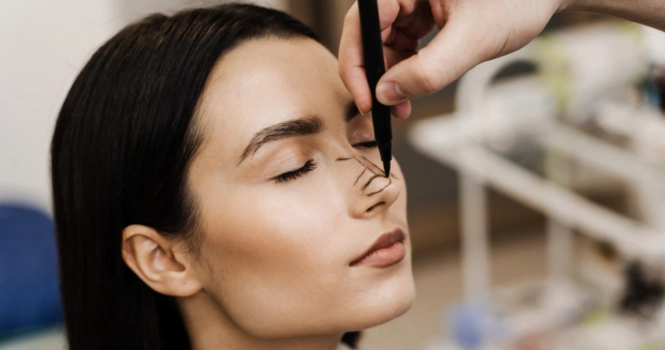We will go through the commonly done Surgical and Non Surgical Procedures in this article
Surgical Procedures
1. Facelift (Rhytidectomy)
Facelift, medically known as rhytidectomy, is a cosmetic surgical procedure aimed at reducing visible signs of aging on the face and neck.
Conducted under general anesthesia or intravenous sedation, the procedure involves making incisions around the hairline and near the ears to tighten underlying tissues and remove excess skin.
The skin is then redraped over the newly repositioned contours, and any excess skin is removed.
The outcome is a rejuvenated appearance with smoother, more youthful skin. Risks associated with a facelift can include infection, scarring, and complications from anesthesia.
Recovery generally takes several weeks, and patients are advised to follow post-operative guidelines carefully to ensure optimal results.
2. Brow Lift
A brow lift, also known as a forehead lift, is a cosmetic surgical procedure aimed at elevating the brow and reducing wrinkles and frown lines on the forehead and between the eyes.
The surgery is often performed under general anesthesia and involves making incisions either along the hairline or in the forehead’s natural creases. The surgeon tightens the underlying muscles and lifts the skin to give the forehead a smoother, more youthful appearance.
The procedure can be done in conjunction with other facial surgeries like a facelift or eyelid surgery for more comprehensive results. Risks include scarring, infection, and complications from anesthesia.
Recovery usually takes around two weeks, during which patients may experience swelling and bruising that gradually subside. Following post-operative guidelines is crucial for achieving the desired outcome.
3. Eyelid Surgery (Blepharoplasty)
Eyelid surgery, medically known as blepharoplasty, is a cosmetic procedure designed to improve the appearance of the eyelids, targeting issues such as drooping lids, puffiness, or bags under the eyes.
The surgery can be performed on the upper lids, lower lids, or both. Typically conducted under local anesthesia with sedation or under general anesthesia, the procedure involves making precise incisions along the natural creases of the eyelids to remove excess skin, fat, or muscle.
The incisions are then closed with sutures, and the area is treated to minimize scarring. Risks include infection, dry eyes, and complications related to anesthesia. Recovery generally takes about two weeks, with some swelling and bruising expected.
Patients are advised to adhere strictly to post-operative care instructions to optimize healing and achieve the best possible results.
4. Rhinoplasty
Rhinoplasty, commonly known as a nose job, is a surgical procedure aimed at reshaping or resizing the nose for cosmetic or functional reasons.
Conducted under general or local anesthesia, the procedure may involve altering the bone, cartilage, or skin of the nose to achieve a desired appearance or improve breathing.
Incisions are generally made inside the nostrils or along the columella, the soft tissue separating the nostrils, to minimize visible scarring. Once the underlying structure is modified, the skin is redraped and the incisions are closed.
Risks associated with rhinoplasty include bleeding, infection, and complications from anesthesia. Recovery usually takes several weeks, with patients often experiencing swelling, bruising, and discomfort initially.
It’s essential to follow post-operative guidelines and consult the surgeon for follow-up appointments to ensure successful healing and satisfactory results.
5. Neck Lift
A neck lift, or lower rhytidectomy, is a cosmetic surgical procedure aimed at improving the appearance of the neck and jawline by reducing sagging skin, excess fat, and muscle banding.
Performed under general anesthesia or intravenous sedation, the surgery involves making incisions behind the ears and possibly under the chin. The surgeon may tighten the platysma muscle, remove excess skin and fat, and reposition tissues to achieve a more youthful and contoured neck profile.
The skin is then redraped and the incisions are closed. Risks include infection, scarring, and complications related to anesthesia. Recovery generally takes two to four weeks, during which patients may experience swelling and bruising.
Adherence to post-operative care guidelines is crucial for minimizing complications and achieving optimal results. A neck lift is often performed in conjunction with other facial surgeries, such as a facelift, for a more comprehensive rejuvenation.
6. Cheek Augmentation
Cheek augmentation is a cosmetic surgical procedure designed to enhance the prominence or fullness of the cheekbones, adding facial balance and a youthful contour.
Various methods can be employed for this procedure, including the use of implants, fat grafting, or dermal fillers. When implants are used, the surgery typically involves making small incisions inside the mouth or lower eyelid, through which the implants are inserted and positioned over the cheekbones.
In fat grafting, fat is harvested from another part of the body, purified, and then injected into the cheeks. Dermal fillers offer a non-surgical alternative but may require repeated treatments to maintain results.
Anesthesia type varies depending on the method used, ranging from local anesthesia with sedation to general anesthesia. Risks include infection, asymmetry, and complications related to anesthesia.
Recovery time varies depending on the procedure, but patients should expect some swelling and bruising initially. Strict adherence to post-operative care is essential for achieving the best possible outcome.
7. Chin Augmentation
Chin augmentation, also known as mentoplasty or genioplasty, is a surgical procedure aimed at enhancing the size, shape, or projection of the chin to achieve better facial harmony.
The surgery often involves inserting an implant into the chin area or reshaping the bone, and it may be performed for cosmetic or reconstructive purposes.
Conducted under general anesthesia or local anesthesia with sedation, the procedure usually involves making an incision either inside the mouth or under the chin to create a pocket where the implant can be placed or to access the bone for reshaping.
Risks associated with chin augmentation include infection, nerve damage, and complications from anesthesia. Recovery time varies but generally ranges from one to three weeks, during which patients may experience swelling, bruising, and discomfort.
Adherence to post-operative guidelines is crucial for minimizing complications and achieving the desired results. Chin augmentation is often done in conjunction with other facial surgeries, such as rhinoplasty or neck lift, for a more harmonious facial appearance.
8. Otoplasty (Ear Surgery)
Otoplasty, commonly known as ear surgery, is a procedure aimed at correcting the shape, position, or size of the ears.
This surgery is often performed to address protruding or overly large ears and can be conducted on children as well as adults. The procedure is typically done under local anesthesia with sedation or under general anesthesia, especially for younger patients.
During the surgery, an incision is usually made behind the ear to expose the cartilage, which is then reshaped, repositioned, or reduced in size. The incisions are then closed with sutures, and the head may be wrapped in bandages to aid in the healing process.
Risks include infection, bleeding, and complications related to anesthesia. Recovery time is generally one to two weeks, with patients advised to avoid strenuous activities that may impact the ears.
Following post-operative guidelines is essential for achieving satisfactory results and minimizing the risk of complications.
9. Hair Transplant
A hair transplant is a cosmetic procedure designed to address hair loss by relocating healthy hair follicles from one part of the body, usually the back or sides of the scalp, to the thinning or balding areas.
The two primary methods for hair transplantation are Follicular Unit Transplantation (FUT) and Follicular Unit Extraction (FUE). In FUT, a strip of scalp is removed, and individual hair follicles are dissected and implanted into the target area.
In FUE, individual follicular units are extracted directly from the donor site and transplanted. The procedure is typically performed under local anesthesia, and the duration varies depending on the number of grafts. Risks include infection, scarring, and uneven hair growth.
Recovery time is generally shorter for FUE compared to FUT, with patients usually able to return to normal activities within a week.
Proper post-operative care, including avoiding strenuous activities and following hygiene guidelines, is crucial for successful hair growth and minimizing complications.
10. Lip Augmentation
Lip augmentation is a cosmetic procedure aimed at enhancing the volume, shape, or symmetry of the lips. Various methods can be used for this purpose, including injectable dermal fillers, fat grafting, or surgical implants.
The most common approach involves the use of hyaluronic acid-based fillers, which offer temporary but natural-looking results. The procedure is usually performed under local anesthesia and involves injecting the chosen material into specific areas of the lips and surrounding regions to achieve the desired fullness and contour.
Surgical options like implants provide a more permanent solution but come with increased risks such as infection, scarring, or implant displacement. Whether using fillers or surgical methods, potential complications can include allergic reactions, infection, and asymmetry.
Recovery time varies depending on the procedure, but most patients can return to regular activities almost immediately after receiving fillers, with some initial swelling and bruising expected.
Strict adherence to post-procedure guidelines is essential for achieving the best possible outcome.
11. Jawline Contouring
Jawline contouring is a cosmetic procedure aimed at enhancing the shape and definition of the jawline and chin, either by reducing a prominent jaw, augmenting a weak jaw, or achieving a more feminine or masculine contour.
Techniques can vary from minimally invasive options like dermal fillers or Botox injections to surgical methods such as bone shaving or implant placement. In surgical jaw contouring, incisions are typically made inside the mouth to minimize visible scarring, and the jawbone may be reshaped or augmented as needed.
The procedure is usually performed under general anesthesia, and risks include infection, nerve damage, and complications related to anesthesia.
Recovery time can vary widely depending on the extent of the surgery, ranging from a few days for injectable treatments to several weeks for more invasive procedures.
Post-operative care is crucial for minimizing risks and achieving the best possible outcome, and patients are often advised to follow a liquid or soft-food diet while healing.
Non-Surgical Procedures
1. Botox Injections
Botox injections are a minimally invasive, non-surgical cosmetic procedure used to temporarily reduce the appearance of fine lines and wrinkles, particularly in the forehead, between the eyebrows, and around the eyes.
Botox works by blocking nerve signals that cause muscles to contract, leading to a more relaxed and smooth appearance of the skin.
The procedure is typically quick, often completed within 15 to 30 minutes, and usually requires no anesthesia, although a topical numbing agent may be applied for comfort.
Results are generally visible within a few days and can last up to several months. Risks are relatively low but can include temporary bruising, headache, or in rare cases, eyelid drooping.
There’s minimal recovery time, and most patients can return to their normal activities immediately after the procedure. Periodic follow-up treatments are necessary to maintain the results.
2. Dermal Fillers (Juvederm, Restylane)
Dermal fillers like Juvederm and Restylane are non-surgical cosmetic treatments used to restore volume, smooth out wrinkles, and enhance facial contours.
These fillers are generally made of hyaluronic acid, a naturally occurring substance in the skin, and are injected directly into the targeted areas. Common treatment zones include the lips, cheeks, and the nasolabial folds that run from the nose to the mouth corners.
The procedure is typically performed under local anesthesia or with the use of a topical numbing agent and takes about 30 minutes to an hour to complete. Results are immediate and can last anywhere from six months to over a year, depending on the product and the area treated.
Risks associated with dermal fillers include swelling, bruising, and in rare cases, allergic reactions or infection. Recovery is minimal, and most patients can resume normal activities shortly after the procedure, although it’s advisable to avoid strenuous exercise for a day or two. Periodic maintenance treatments are required to sustain the results.
3. Laser Hair Removal
Laser hair removal is a non-surgical cosmetic procedure designed to reduce unwanted body hair by using concentrated beams of light to target and destroy hair follicles.
The procedure is most effective on individuals with a contrast between their skin tone and hair color and can be used on various parts of the body, including the face, arms, legs, and bikini area.
The treatment usually involves multiple sessions spaced several weeks apart for optimal results. While generally considered safe, laser hair removal can cause temporary side effects like redness, swelling, and irritation.
More serious risks, although rare, include burns and skin discoloration. Anesthesia is usually not required, but a topical numbing agent may be applied for comfort. Recovery is minimal, and most people can return to regular activities immediately after treatment.
However, it is advised to avoid sun exposure and to use sunscreen to protect the treated area. Periodic maintenance treatments may be needed to achieve long-lasting results.
4. Chemical Peels
Chemical peels are non-surgical skin treatments that use a chemical solution to remove the damaged outer layers of skin, thereby improving the texture and appearance of the skin.
These peels are commonly used to treat fine lines, acne scars, hyperpigmentation, and sun damage. The procedure can range from mild to deep, depending on the concentration and type of acid used.
Mild peels, often using alpha hydroxy acids, require little to no downtime and produce subtle results. Medium to deep peels, which may involve trichloroacetic acid or phenol, achieve more dramatic results but come with increased risks and longer recovery periods.
Side effects can include redness, peeling, and sensitivity, and in rare cases, scarring or infection may occur. Patients are generally advised to avoid sun exposure and to meticulously follow after-care instructions to minimize risks and optimize results. A consultation with a qualified medical professional is crucial to determine the most appropriate type of peel for an individual’s skin type and concerns.
5. Microneedling
Microneedling, also known as collagen induction therapy, is a non-surgical cosmetic procedure designed to stimulate collagen production and rejuvenate the skin. The treatment involves the use of a device equipped with fine needles to create controlled micro-injuries in the skin, triggering the body’s natural healing process.
Microneedling is commonly used to treat a variety of skin issues, including fine lines, acne scars, enlarged pores, and uneven skin texture. The procedure usually takes about 30 minutes to an hour and is often performed under topical anesthesia to minimize discomfort.
Side effects are typically mild and may include redness, swelling, and slight bleeding, similar to a mild sunburn. Recovery is generally quick, with most patients able to return to normal activities within a day or two, although it is advisable to avoid sun exposure and strenuous activities for a short period.
Multiple sessions are often recommended for optimal results, and it is crucial to consult a qualified medical professional for a personalized treatment plan.
6. Laser Skin Resurfacing
Laser skin resurfacing is a non-surgical cosmetic procedure that uses concentrated beams of light to remove damaged skin cells and stimulate the growth of new, healthy skin.
The treatment is commonly used to address issues such as fine lines, wrinkles, acne scars, sun damage, and uneven skin tone. There are various types of lasers used for skin resurfacing, including ablative lasers, which remove the outer layers of skin, and non-ablative lasers, which heat the underlying skin tissue without harming the surface.
The procedure is typically performed under local anesthesia or sedation, and the duration varies depending on the area being treated. Side effects can include redness, swelling, and peeling, with recovery times ranging from a few days for non-ablative treatments to several weeks for ablative methods.
Potential risks include scarring, infection, and pigmentation changes. It is crucial to follow post-procedure care guidelines and to protect the skin from sun exposure to achieve optimal results. A consultation with a qualified healthcare provider is essential for determining the most suitable type of laser and treatment plan.
7. CoolSculpting
CoolSculpting is a non-surgical cosmetic procedure designed to reduce stubborn fat deposits through a method known as cryolipolysis. The treatment involves the application of cooling panels that freeze and destroy fat cells without damaging the surrounding tissues.
Common treatment areas include the abdomen, thighs, flanks, and double chin. The procedure is typically painless and requires no anesthesia, although patients may experience a sensation of cold and pulling during the treatment.
Each session lasts about 30 minutes to an hour, and multiple sessions may be required for optimal results. Side effects are generally minimal and can include temporary redness, swelling, and numbness in the treated area.
There’s little to no downtime, and most patients can resume regular activities immediately following the treatment. However, results are not immediate; it may take several weeks to months to see the full effects as the body naturally eliminates the destroyed fat cells.
While generally considered safe, risks include potential uneven fat reduction and rare complications like paradoxical adipose hyperplasia. Consulting with a qualified healthcare provider is essential for an individualized treatment plan.
8. Ultherapy (Ultrasound Skin Tightening)
Ultherapy is a non-surgical cosmetic procedure that uses focused ultrasound energy to lift and tighten loose skin. Commonly targeted areas include the face, neck, and décolletage.
The procedure stimulates the production of collagen, improving skin elasticity and reducing the appearance of sagging skin. Ultherapy is often performed in a single session lasting between 30 to 90 minutes, depending on the treatment area.
While anesthesia is not typically required, some patients may opt for a topical numbing agent or mild sedation to minimize discomfort during the treatment. Side effects are generally mild and can include temporary redness, swelling, and tenderness in the treated areas.
Recovery is minimal, with most patients able to return to regular activities immediately after the procedure. Results typically become apparent over the course of two to three months as new collagen forms and lifts the skin.
Although considered a safer alternative to surgical procedures for skin tightening, risks can include temporary numbness or tingling. As with any cosmetic treatment, consultation with a qualified healthcare provider is essential for determining suitability and tailoring the treatment to individual needs.
9. IPL (Intense Pulsed Light)
Intense Pulsed Light (IPL) is a non-surgical cosmetic procedure that uses broad-spectrum light to target various skin issues, such as pigmentation, redness, and broken blood vessels, as well as to improve skin texture.
Unlike lasers, which use a single wavelength of light, IPL uses a range of wavelengths to treat different layers of the skin. The procedure is commonly used on the face, but it can also be applied to other areas like the neck, chest, and hands.
Typically performed in a series of sessions, each IPL treatment takes approximately 20 to 30 minutes and may involve some discomfort, akin to the snapping of a rubber band against the skin.
Topical anesthesia or cooling gels may be used for comfort. Side effects are generally mild and can include temporary redness, swelling, and darkening of pigmented spots.
Most people can resume regular activities immediately, although it’s crucial to avoid sun exposure and to use sunscreen post-treatment. Risks of IPL include burns, scarring, or changes in skin pigmentation, particularly if not performed by a qualified practitioner.
Therefore, consultation with a healthcare provider is essential for an individualized treatment plan.
10. Sclerotherapy
Sclerotherapy is a non-surgical procedure commonly used to treat varicose veins and spider veins.
In this treatment, a sclerosing agent is injected directly into the affected veins, causing them to collapse and eventually be reabsorbed by the body. This leads to improved appearance and reduced discomfort associated with enlarged veins.
The procedure is usually performed in a doctor’s office and takes between 15 to 45 minutes, depending on the number of veins being treated. Local anesthesia is generally not required, although some individuals may experience mild discomfort during the injections.
After the procedure, patients are often advised to wear compression stockings to aid in the healing process and improve outcomes.
Common side effects include temporary bruising, swelling, and redness around the injection sites. More serious but rare complications can include allergic reactions to the sclerosing agent, deep vein thrombosis, and skin ulcers.
Most patients can return to regular activities immediately following the treatment, but strenuous exercise and sun exposure are usually discouraged for a period.
Multiple sessions may be required for optimal results, and consultation with a qualified healthcare provider is essential to determine suitability for the treatment.
11. PRP (Platelet-Rich Plasma) Therapy
Platelet-Rich Plasma (PRP) Therapy is a non-surgical cosmetic procedure that uses the patient’s own plasma to promote skin rejuvenation, hair growth, and tissue healing.
In this treatment, a small sample of the patient’s blood is drawn and centrifuged to separate the plasma and platelets from the other blood components. The concentrated PRP is then injected back into the targeted areas, releasing growth factors that stimulate cellular regeneration and collagen production.
PRP therapy is commonly used for facial rejuvenation, treating fine lines and improving skin texture, as well as for addressing hair loss. The procedure typically takes about 30 minutes to an hour and is often performed under topical anesthesia to minimize discomfort.
Side effects are usually minimal, given that the patient’s own blood is used, but can include temporary redness, swelling, and bruising. There is minimal downtime, and most people can return to normal activities shortly after the procedure.
Results vary by individual and multiple sessions are often recommended for optimal outcomes. While generally considered safe, it’s crucial to consult with a qualified healthcare provider for an individualized treatment plan and to discuss any potential risks, such as infection or allergic reactions.
12. Thread Lift
A thread lift is a minimally invasive, non-surgical cosmetic procedure designed to lift and tighten sagging skin on the face, neck, or body.
The treatment involves the insertion of dissolvable sutures with tiny barbs or cones under the skin to grasp, lift, and suspend the tissue. These threads also stimulate collagen production, leading to a more youthful appearance over time.
The procedure usually takes between 30 minutes to an hour and is often performed under local anesthesia to minimize discomfort. Results are immediately visible and can last up to 18 months, depending on the type of threads used and individual factors.
Common side effects include temporary redness, swelling, and bruising, but these usually subside within a few days.
Risks can include infection, asymmetry, and in rare cases, nerve damage or thread migration. Recovery time is minimal, and most patients can resume normal activities within a couple of days, although strenuous exercise is typically discouraged for a few weeks.
Consultation with a qualified healthcare provider is crucial for assessing suitability for the procedure and discussing individual treatment goals and potential risks.













